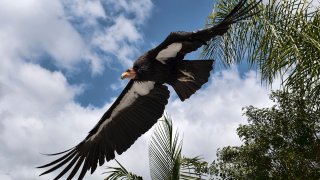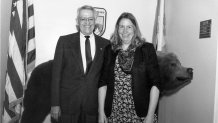
On Dec. 28, 1973, President Richard Nixon signed the Endangered Species Act. “Nothing,” he said, “is more priceless and more worthy of preservation than the rich array of animal life with which our country has been blessed.” The powerful new law charged the federal government with saving every endangered plant and animal in America and enjoyed nearly unanimous bipartisan support.
The Act was so sweeping that, in retrospect, it was bound to become controversial, especially since it allowed species to be listed as endangered without consideration for the economic consequences. In that way it pitted two American values against each other: the idea that Americans should preserve their incredible natural resources (the United States invented the national park, after all) and the notion that capitalism was king and private property inviolate.
The Endangered Species Act was just one in a raft of environmental legislation passed beginning in the mid-1960s that included the Clean Water Act, the Clean Air Act, the Wilderness Act and the National Wild and Scenic Rivers Act. Taken together, it was the most extensive environmental legislation the world had ever seen.
It was a time of widespread support for cleaning up the environment after unchecked greed had polluted our air and water and wiped out some of our most iconic species. Added to the desire for a cleaner natural world was a belief that the federal government could solve our nation’s problems.
Get DFW local news, weather forecasts and entertainment stories to your inbox. Sign up for NBC DFW newsletters.
The United States' own national animals, the bison and the bald eagle, had been driven to near extinction. When they started to recover, Americans saw the Endangered Species Act as a success. But when animals that people had never heard of began interfering with development, it was a different story.
Left to navigate this minefield was a group of young biologists in Washington — the first Office of Endangered Species.
The Snail Darter
Ichthyologist Jim Williams, the office's first “fish guy,” was hired in 1974. He describes his cohort as “a bunch of conservation-minded biologists that were all on a mission to save every last one of our chosen group of organisms come hell or high water, and, by the way, to hell with the bureaucrats and politicians.”
His unconventional attitude and methods soon became apparent with the listing of the snail darter, a little fish now so notorious it has become synonymous with government overreach. At the time, it was only known to exist in the Little Tennessee River — which the Tennessee Valley Authority was planning to dam.
“I started talking about listing it, and boy, oh boy, did the crap hit the fan,” Williams says.
His boss told him the listing was so controversial it might spell the end of the Endangered Species Act. It didn't. But the law would never again enjoy the support of its earliest days. Whether the government should try to save all species from extinction, or if not, where to draw the line, became a point of conflict that has never been fully resolved.

(Courtesy of C. Kenneth Dodd Jr. via AP)
‘Save Ken Dodd and Rattlesnakes’
Herpetologist Ken Dodd was recruited to the office in 1976.
“There was not a whole lot of conservation theory at the time to draw on,” he says. “So we were really at the cutting edge of determining what is necessary for conservation."
Like Williams, Dodd regularly butted heads with administrators. He also followed the science where it led without thought for whom it might inconvenience. But the thing that actually got him fired — in 1979 — was not a listing but a letter.
A man named Dominique D’Ermo owned a Washington restaurant that was serving rattlesnake meat he said came from Pennsylvania. That would have violated a law called the Lacey Act. “So I wrote to the restaurant and said, ‘Hey, Dominique, I think you need to get a better source,’” Dodd says.
It turned out Interior Secretary Cecil Andrus was a patron. When he learned what Dodd had done, “He fired me."
Dodd obtained an attorney. Meanwhile, according to Williams, “We all went down to a T-shirt shop, got shirts that said ‘Save Ken Dodd and Rattlesnakes’.”
The ensuing publicity made an impact. Soon, Dodd was back at work.
Gray Wolf Season
Mammologist Ron Nowak joined the office in 1973. The animals he was responsible for were often furry and charismatic, but he still had problems with his listings.
In the 1980s the gray wolf was coming back in Minnesota from “just a tiny remnant of a couple hundred animals to maybe several hundred or a thousand” thanks to the Endangered Species Act. Wildlife officials wanted to open a hunting season. That would require a regulation showing it would benefit the wolves and was the only way to control their population.
“They told me, ‘You have to write the regulation,’” Nowak says. “And I said, ‘It would be illegal.’”
Someone else wrote the regulation. Conservation groups sued, calling Nowak as a witness. The conservation groups won.
Nowak's success may have made him overconfident, he said, because he then sought outside help that forced the agency to move on a stalled listing for the Louisiana black bear, the inspiration for the original teddy bear. By late 1987, his unit had been “dismembered” and he was reassigned.
Today, Nowak has nothing but praise for his colleagues.
“They wanted to show a true reflection of that part of the natural world that was in danger of disappearing,” he says. “You could go there at night or on weekends, and they’d be there, not for any extra pay, but just because they believed in it.
“And you could find them out in the field, sometimes, actually going to just try to look for these animals and plants. Really, I think it was a unique place — one that we may never see again.”
Climate Change and the California Condor
LaVerne Smith was hired in 1978 as one of the Office of Endangered Species’ first botanists. Unlike many of her colleagues, she continued to work in the endangered species program for most of her career, through many office reorganizations.
That included a 1987 shuffle that moved the responsibility for listing species to regional offices — a reorg controversial enough that it prompted a eulogy of sorts in The New York Times. “The Office of Endangered Species has gone the way of the dusky seaside sparrow and the Sampson’s pearly mussel," the story read. “Like six of the species that it was created to protect in 1973, it has become extinct.”
When Smith was hired, only nine years earlier, “It still felt very, very new."
“The agency was just getting hiring people, getting staffed up, trying to figure out what to do with this amazing new piece of legislation,” she says. "So it was it was a pretty exciting time.”
One of the early decisions involved the critically endangered California condor, whose numbers had dwindled to 23 by 1982. Biologists debated if they should they watch the condors go extinct or bring those final birds into captivity and try to breed them. If they did, what would be the likelihood of success?
High, it turned out. “They’re out sailing around in California again. They’re out sailing around the Grand Canyon. And I think anyone who’s seen one — the day I saw one sail over the Grand Canyon, I was like, ‘Oh my God! That was all worth it.’”
Smith later transferred to Alaska, where she led the listing for the polar bear, the first animal to be listed as endangered because of climate change.
“That is a whole new era of challenge for the agency. I think it means a whole lot more species are going to be impacted," she says. "It means that you’ve got to make decisions much quicker because of the pace that the threat is occurring.”
Smith hopes there is still some resiliency in the natural systems, “like during COVID when everybody sort of stopped, hit the pause button for a while, and all the air cleaned up.”
“People were very worried that we would never be able to do anything for the condor," she says. "Certainly it still requires a lot of protection and a lot of help, but it’s still out there. … If you want to be in the conservation business, you have to hang on to hope.”

(U.S. Fish and Wildlife Service via AP)
Mission: Impossible
Marc Imlay studies mollusks. He is a malacologist who began working at the Office in 1971, before the current Endangered Species Act was passed. He was focused on freshwater mussels — which, it turns out, is one of the most critically endangered groups of organisms in the country.
One of their biggest threats was dams. Imlay surreptitiously stopped TVA and the Army Corps of Engineers from building eight of them.
“I decided that they destroyed a lot of habitat, and I would call this guy with the Sierra Club in Missouri and say, ‘Did you know there’s an endangered mussel there?'” It worked. The dam was stopped.
Though the Endangered Species Act prohibits the federal government from doing anything that would harm an endangered species, Imlay says that if he wanted to keep his job, he sometimes had to work around the bureaucracy.
“That’s how I did it. Secretively," he says. "Oops.”
But many times in his career, he has found solutions that satisfied everyone. “Time and time again, you can work with a developer. Identify high quality land. Leave that alone. So you put the housing where you protect the existing natural areas.”
“I tell young people, I’ve accomplished Mission: Impossible at least a third of the time in my life.”
The Boss
John Spinks was an early chief of the Office of Endangered Species. He had the unenviable task of managing his band of misfit biologists.
“People who really put their heart and soul into those kind of specific studies are special," he says. "I mean, they bleed for their species. And I was just extremely fortunate to have that group of talented people. And my main job was to stay out of the way and let them do their job.”
Spinks was apparently aware of the propensity for some of his staff to make end runs around the bureaucracy. At one point there was a particular listing that was being blocked by Interior Department attorneys.
“I wrote a memorandum to someone above me in the agency. And for some reason, that memorandum got leaked to The Washington Post. God only knows how that happened.”
The leak “caused all hell to break loose.”
“This memorandum clearly showed the solicitor’s office as being a deliberate roadblock that kept species from being listed. … And of course, we were as clean as the driven snow. There was nothing that would ever come back to us. That was many years ago, but I still think about that with great satisfaction.”



